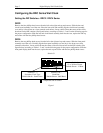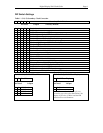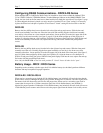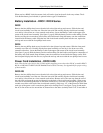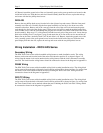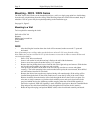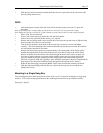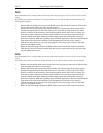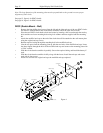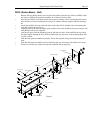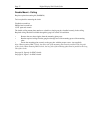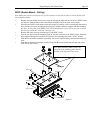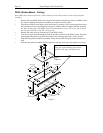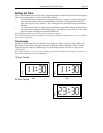
Page 13 Digital Display Wall Clock Guide
DDC2
Note: If mounting near a ceiling, make sure the top of the single gang box is at least 2 1/4" away from the
ceiling.
Note: Make sure you have at least 10 1/2" of side clearance on one side in order to remove the lens and
circuit board assembly.
» Remove the four phillips head screws from the left or the right end cap and remove. Slide the lens
and circuit board assembly out of the case and set aside.
» Remove the desired vent cap that any required wiring will route through. (If the wiring will be
installed through the back-of-the-clock conduit access, route the fly leads of the clock's Cable
Harness Assembly from the interior of the clock through the hole in the Clock's rear plate. Use
wire nuts or crimp connectors to join these leads with the power and synch signal cable in the
gang box behind the clock to eliminate possible snagging when the circuit board assembly is
removed or replaced. If RS-485 signaling is used, attach the signal pair to the mini Terminal Block
Plug and pass the cable from behind the clock, through the hole into the clock's interior).
» Line the two holes in the case up to the single gang box and insert proper screws for the single
gang box and tighten securely.
» Route the 6-position plug (and optional RS485 cable) to the circuit board assembly and attach.
» Slide the lens and circuit board assembly back into the case, replace the end cap and secure with
the four phillips head screws.
DDC4
Note: If mounting near a ceiling, make sure the top of the single gang box is at least 2 1/4" away from the
ceiling.
Note: Make sure you have at least 16" of side clearance on one side in order to remove the front panel.
» Remove the two phillips head screws from the left or the right end cap and remove. Slide the front
panel assembly out of the case and set aside.
» Remove the desired vent cap that any required wiring will route through. (If the wiring will be
installed through the back-of-the-clock conduit access, route the fly leads of the clock's Cable
Harness Assembly from the interior of the clock through the hole in the Clock's rear plate. Use
wire nuts or crimp connectors to join these leads with the power and synch signal cable in the
gang box behind the clock to eliminate possible snagging when the circuit board assembly is
removed or replaced. If RS-485 signaling is used, attach the signal pair to the mini Terminal Block
Plug and pass the cable from behind the clock, through the hole into the clock's interior).
» Line the two holes in the case up to the single gang box and insert proper screws for the single
gang box and tighten securely.
» Route the 6-position plug (and optional RS485 cable) to the circuit board assembly and attach.



